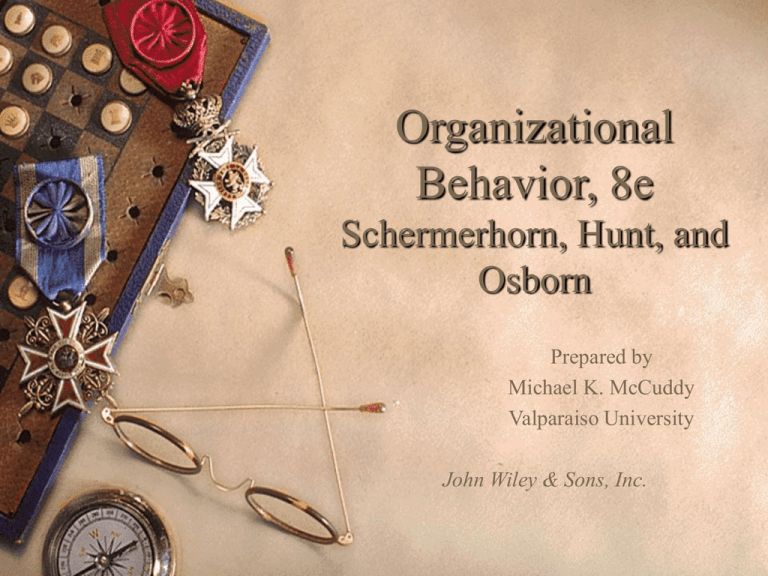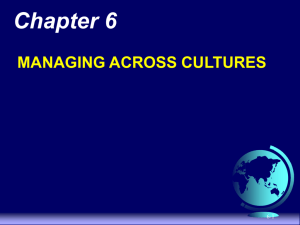
Organizational
Behavior, 8e
Schermerhorn, Hunt, and
Osborn
Prepared by
Michael K. McCuddy
Valparaiso University
John Wiley & Sons, Inc.
COPYRIGHT
Copyright 2003 © John Wiley & Sons, Inc. All rights reserved.
Reproduction or translation of this work beyond that permitted in Section
117 of the 1976 United States Copyright Act without the express written
permission of the copyright owner is unlawful. Request for further
information should be addressed to the Permissions Department, John Wiley
& Sons, Inc. The purchaser may make back-up copies for his/her own use
only and not for distribution or resale. The Publisher assumes no
responsibility for errors, omissions, or damages, caused by the use of these
programs or from the use of the information contained herein.
Organizational Behavior: Chapter 3
2
Chapter 3
Global Dimensions of
Organizational Behavior
Study questions.
– Why is globalization significant to
organizational behavior?
– What is culture?
– How does globalization affect people at work?
– What is a global view on organizational
learning?
Organizational Behavior: Chapter 3
3
Why is globalization significant to
organizational behavior?
Most organizations must achieve high
performance within a complex and
competitive global environment.
Organizational Behavior: Chapter 3
4
Why is globalization significant to
organizational behavior?
Globalization involves complex economic
networks of competition, resource supplies,
and product markets transcending national
boundaries and circling the globe.
Organizational Behavior: Chapter 3
5
Why is globalization significant to
organizational behavior?
A global economy.
– Information technology and electronic
communications have:
• Promoted a global economy.
• Created Internet business opportunities.
– Transnational movement of products, trends,
values, and innovations.
– Multicultural workforces.
Organizational Behavior: Chapter 3
6
Why is globalization significant to
organizational behavior?
Regional economic alliances.
– European Union (EU).
– North American Free Trade Agreement
(NAFTA).
– Caribbean Community (CARICOM).
– Andean Pact.
– Asia-Pacific Economic Co-operation Forum
(APEC).
Organizational Behavior: Chapter 3
7
Why is globalization significant to
organizational behavior?
Global quality standards.
– ISO designation for quality standards.
– ISO framework for quality assurance
worldwide.
– ISO certification is important for doing
business in Europe and developing a
reputation as a “world-class” manufacturer.
Organizational Behavior: Chapter 3
8
Why is globalization significant to
organizational behavior?
Global managers.
– A global manager is someone who knows how
to conduct business across borders.
– The global manager:
• Is often multilingual.
• Thinks with a world view.
• Appreciates diverse beliefs, values, behaviors, and
practices.
• Is able to map strategy in light of the above.
Organizational Behavior: Chapter 3
9
Why is globalization significant to
organizational behavior?
Challenges facing global managers.
– Managers’ styles and attitudes may not work
well overseas.
– A global mindset is required in order to avoid
failure.
Organizational Behavior: Chapter 3
10
What is culture?
Culture is the learned, shared way of doing
things in a particular society.
Culture helps to define the boundaries
between different groups and affect how
their members relate to one another.
Organizational Behavior: Chapter 3
11
What is culture?
Popular dimensions of culture include:
– Language.
– Time orientation.
– Use of space.
– Religion.
Organizational Behavior: Chapter 3
12
What is culture?
Language.
– Perhaps the most visible aspect of culture.
– Whorfian hypothesis — considers language as
a major determinant of thinking.
– Low-context cultures — the message is
conveyed by the words used.
– High-context cultures — use words to convey
only a limited part of the message.
Organizational Behavior: Chapter 3
13
What is culture?
Time orientation.
– Polychronic cultures.
• Circular view of time.
• Does not create pressure for immediate action or
performance.
• Emphasis on the present.
– Monochronic cultures.
• Linear view of time.
• Creates pressure for action and performance.
• Long-range goals and planning are important.
Organizational Behavior: Chapter 3
14
What is culture?
Use of space.
– Proxemics.
• The study of how people use space to
communicate.
• Reveals important cultural differences.
– Concept of personal space varies across
cultures.
– Space is arranged differently in different
cultures.
Organizational Behavior: Chapter 3
15
What is culture?
Religion.
– A major element of culture.
– Can be a very visible aspect of culture.
– Often prescribes specific behavioral practices.
– Influences codes of ethics and moral behavior.
– Influences conduct of economic matters.
Organizational Behavior: Chapter 3
16
What is culture?
Values and national culture.
– Cultures vary in underlying patterns of values
and attitudes.
– Hofstede’s five dimensions of national culture:
•
•
•
•
•
Power distance.
Uncertainty avoidance.
Individualism-collectivism.
Masculinity-femininity.
Long-term/short-term orientation.
Organizational Behavior: Chapter 3
17
What is culture?
Power distance.
– The willingness of a culture to accept status
and power differences among members.
– Respect for hierarchy and rank in
organizations.
– Example of a high power distance culture —
Indonesia.
– Example of a low power distance culture —
Sweden.
Organizational Behavior: Chapter 3
18
What is culture?
Uncertainty avoidance.
– The cultural tendency toward discomfort with
risk and ambiguity.
– Preference for structured versus unstructured
organizational situations.
– Example of a high uncertainty avoidance
culture — France.
– Example of a low uncertainty avoidance
culture — Hong Kong.
Organizational Behavior: Chapter 3
19
What is culture?
Individualism-collectivism.
– The cultural tendency to emphasize individual
or group interests.
– Preferences for working individually or in
groups.
– Example of an individualistic culture —
United States.
– Example of a collectivist culture — Mexico.
Organizational Behavior: Chapter 3
20
What is culture?
Masculinity-femininity.
– The tendency of a culture to value
stereotypical masculine or feminine traits.
– Emphasizes competition/assertiveness versus
interpersonal sensitivity/relationships.
– Example of a masculine culture — Japan.
– Example of a feminine culture — Thailand.
Organizational Behavior: Chapter 3
21
What is culture?
Long-term/short-term orientation.
– The tendency of a culture to emphasize futureoriented values versus present-oriented values.
– Adoption of long-term or short-term
performance horizons.
– Example of a long-term orientation culture —
South Korea.
– Example of a short-term orientation culture —
United States.
Organizational Behavior: Chapter 3
22
What is culture?
Values and national culture.
– Hofstede’s five dimensions of national culture
are:
• Interrelated.
• Not independent.
– Cultural dimensions typically cluster together.
Organizational Behavior: Chapter 3
23
What is culture?
Understanding cultural differences.
– Two problems in international dealings:
parochialism and ethnocentrism.
– Parochialism — assuming that the ways of
one’s own culture are the only ways of doing
things.
– Ethnocentrism — assuming that the ways of
one’s culture are the best ways of doing things.
Organizational Behavior: Chapter 3
24
What is culture?
The Trompenaars’ framework for
understanding cultural differences in the
way people solve problems regarding:
– Handling relationships with other people.
– Attitudes toward time.
– Attitudes toward the environment.
Organizational Behavior: Chapter 3
25
What is culture?
Cultural differences in handling
relationships with other people.
– Universalism versus particularism.
– Individualism versus collectivism.
– Neutral versus affective.
– Specific versus diffuse.
– Achievement versus prescription.
Organizational Behavior: Chapter 3
26
What is culture?
Cultural differences in attitudes toward
time.
– Sequential view of time.
• Time is a passing series of events.
– Synchronic view of time.
• Time consists of an interrelated past, present, and
future.
Organizational Behavior: Chapter 3
27
What is culture?
Cultural differences in attitudes toward the
environment.
– Inner-directed cultures.
• Members view themselves as separate from nature
and believe they can control it.
– Outer-directed cultures.
• Members view themselves as part of nature and
believe they must go along with it.
Organizational Behavior: Chapter 3
28
How does globalization
affect people at work?
Multinational employers.
– Multinational corporation (MNC).
• A business firm that has extensive international
operations in more than one foreign country.
– MNC characteristics.
• Missions and strategies are worldwide in scope.
• Has a total world view without allegiance to any
one national home.
• Has enormous economic power and impact.
Organizational Behavior: Chapter 3
29
How does globalization
affect people at work?
Multicultural workforces.
– Styles of leadership, motivation, decision
making, planning, organizing, and controlling
vary from country to country.
– Domestic multiculturalism.
• Describes cultural diversity within a specific
national population.
• Reflected in the workforces of local organizations.
Organizational Behavior: Chapter 3
30
How does globalization
affect people at work?
Expatriate work assignments.
– Expatriates.
• People who live and work abroad for extended
periods of time.
• Can be very costly for employers.
• Progressive employers take supportive measures to
maximize potential for expatriate success.
• Greatest problems occur when entering and
working in a foreign culture and upon return home.
Organizational Behavior: Chapter 3
31
How does globalization
affect people at work?
Expatriate work assignments — cont.
– Phases of expatriate adjustment to a new
country.
• Tourist stage — the expatriate enjoys discovering
the new culture.
• Disillusionment stage — the expatriate’s mood is
dampened as difficulties become more evident.
• Culture shock — confusion, disorientation, and
frustration in the ways of the local culture and
living in the foreign environment set in.
Organizational Behavior: Chapter 3
32
How does globalization
affect people at work?
Expatriate work assignments — cont.
– Considerations in reentry to home country.
• Expatriates should maintain adequate contact with
home office during overseas assignment.
• Employers should provide support for reentry
move.
• Employers should identify any new skills and
abilities acquired during overseas experience, and
make commensurate job assignments.
Organizational Behavior: Chapter 3
33
How does globalization
affect people at work?
Ethical behavior across cultures.
– Ethical challenges result from:
• Cultural diversity.
• Variations in governments and legal systems.
– Prominent current issues:
• Corruption and bribery.
• Poor working conditions.
• Child and prison labor.
• Support of repressive governments.
Organizational Behavior: Chapter 3
34
How does globalization
affect people at work?
Ethical behavior across cultures — cont.
– Cultural relativism.
• The position that there is no universal moral
standard.
• Ethical behavior is determined by cultural context.
– Ethical absolutism.
• The position that there is a single moral standard
that fits all situations.
• Ethical behavior transcends cultural context.
Organizational Behavior: Chapter 3
35
What is a global view on
organizational learning?
Global organizational learning.
– The ability to gather from the world at large
the knowledge required for long-term
organizational adaptation.
Organizational Behavior: Chapter 3
36
What is a global view on
organizational learning?
Are management theories universal?
– Answer is “no.”
– Cultural influences should be carefully
considered in transferring theories and their
applications across cultures.
Organizational Behavior: Chapter 3
37
What is a global view on
organizational learning?
Best practices around the world.
– What is being done well elsewhere may be of
great value at home.
– Best practices no longer mainly North
American or European.
– Best practices can be found throughout the
world.
Organizational Behavior: Chapter 3
38



